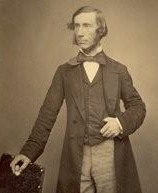Cliff’s first talk to us in April 2013 was on the oil fields in Derbyshire, which was brilliantly delivered and we looked forward to this one. We were not dissappointed.
Cliff was a Chemical Engineer working in the Oil Industry which brought him into contact with scientists in different spheres of influence, which inspired his interest in Climate Change (as opposed to ‘weather’), which is a very complex subject.
Firstly he explained to us how the variations in the earths orbit, rotation, and inclination affected the varying amount of heat and radiation reaching different parts of our planet, over time. The amount given off by the sun also varies. Some of these variations are cyclical and the time scales can be huge, causing climate change in the natural course of events.
Secondly we learnt how the heat and radiation from the sun was reflected or absorbed at different stages throughout our atmosphere, until the remainder reaches the surface of the earth.

John Tyndall (1820 – 1893) originally conducted experiments on how different gases transferred heat and radiation, and his equipment is on display at the Royal Institution.
Taken as an average over the whole globe, the heat reaching the surface of the planet today is approximately 342watts/square metre.
To understand the climate, the Intergovernmental Panel on Climate Change (IPCC) was formed in 1988, by the UN, to assess all the information available from some of the best scientists in the world. 195 countries contribute at present.
Climate information from millions of years ago, can be ascertained from cores taken in ice in the Antarctic and these show cyclical trends as well as events like volcanic action spreading ash into the atmosphere, but these were times when man did not really figure on the planet.
Physical records of climate from around 1600 A.D. have also been kept and show a stable cycle of changes until the beginning of the Industrial Revolution in the early 1800s when the global warming effects (greenhouse gases) of mostly carbon dioxide, methane and nitrous oxide in the atmosphere have been noted to be dramatically and substantially increasing. 100ppm of carbon dioxide increase in the atmosphere causes 1.5 watts increased heat/sq. m. on the Earths surface, and causes the oceans to rise 3mm which affects 10 metres of the shore.
The total world population has doubled to 7 billion people in the last 50 years and is increasing rapidly, causing greenhouse gas emissions by new industrial countries like China and India, to also increase worryingly.
The oceans heat up and expand, and the conveyor belt of ocean currents become susceptible to change e.g. the Gulf Stream and El Nino, affecting weather. This also changes the pH value of the sea water, which in turn destroys susceptible marine environments.
We were shown irrefutable evidence that man is causing the climate to change.
A fascinating talk, very professionally delivered, which generated many questions. Cliff could only suggest that we all tried to save energy in our daily lives to combat the problem, and hope that the world could be persuaded to give up the carbon producing fossil fuels coal, oil, and gas, in that order, and be replaced by environmentally friendly sources of energy.
(Cliffs fee today went to the Arkwright Mill project at Cromford.)
